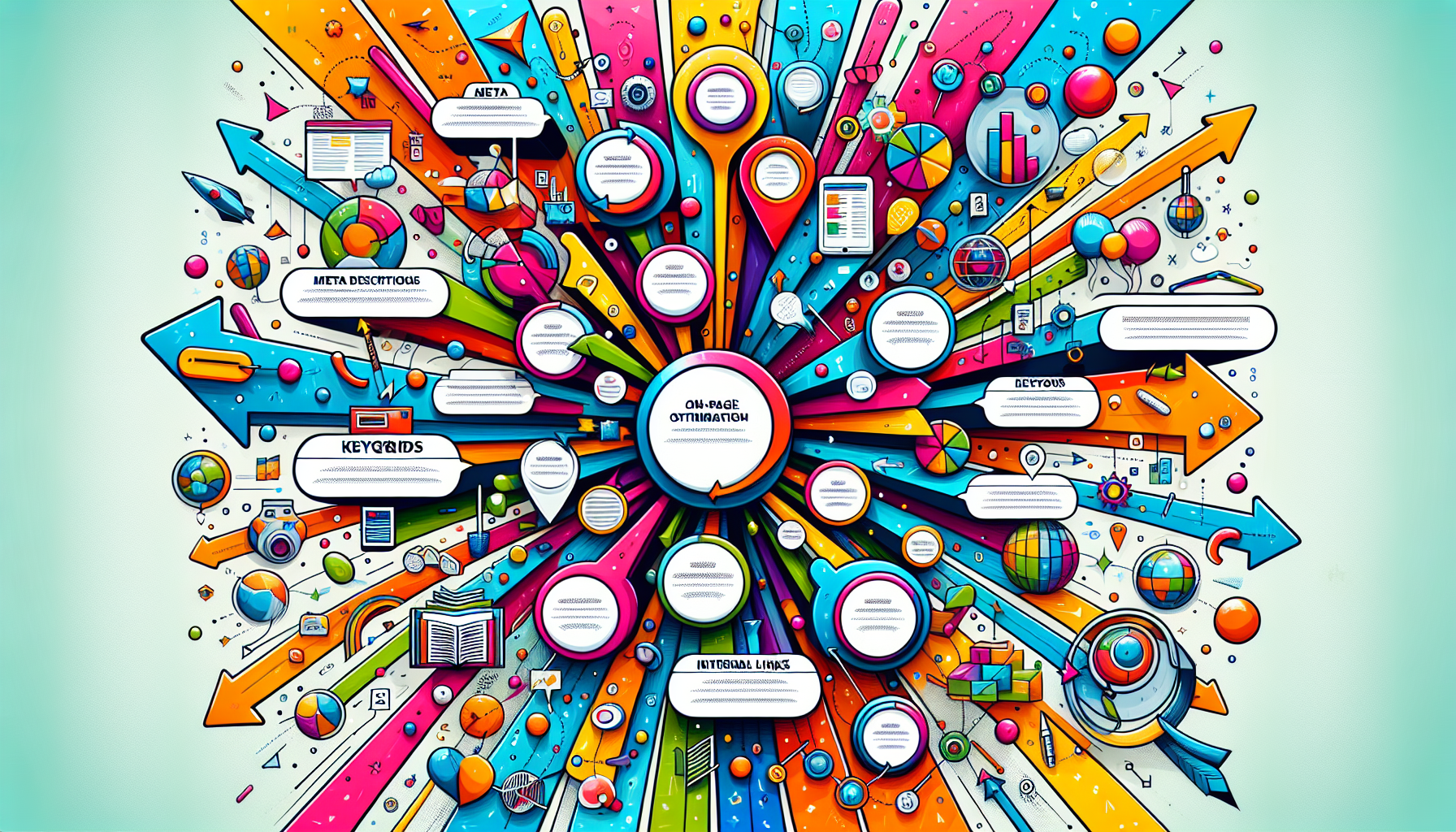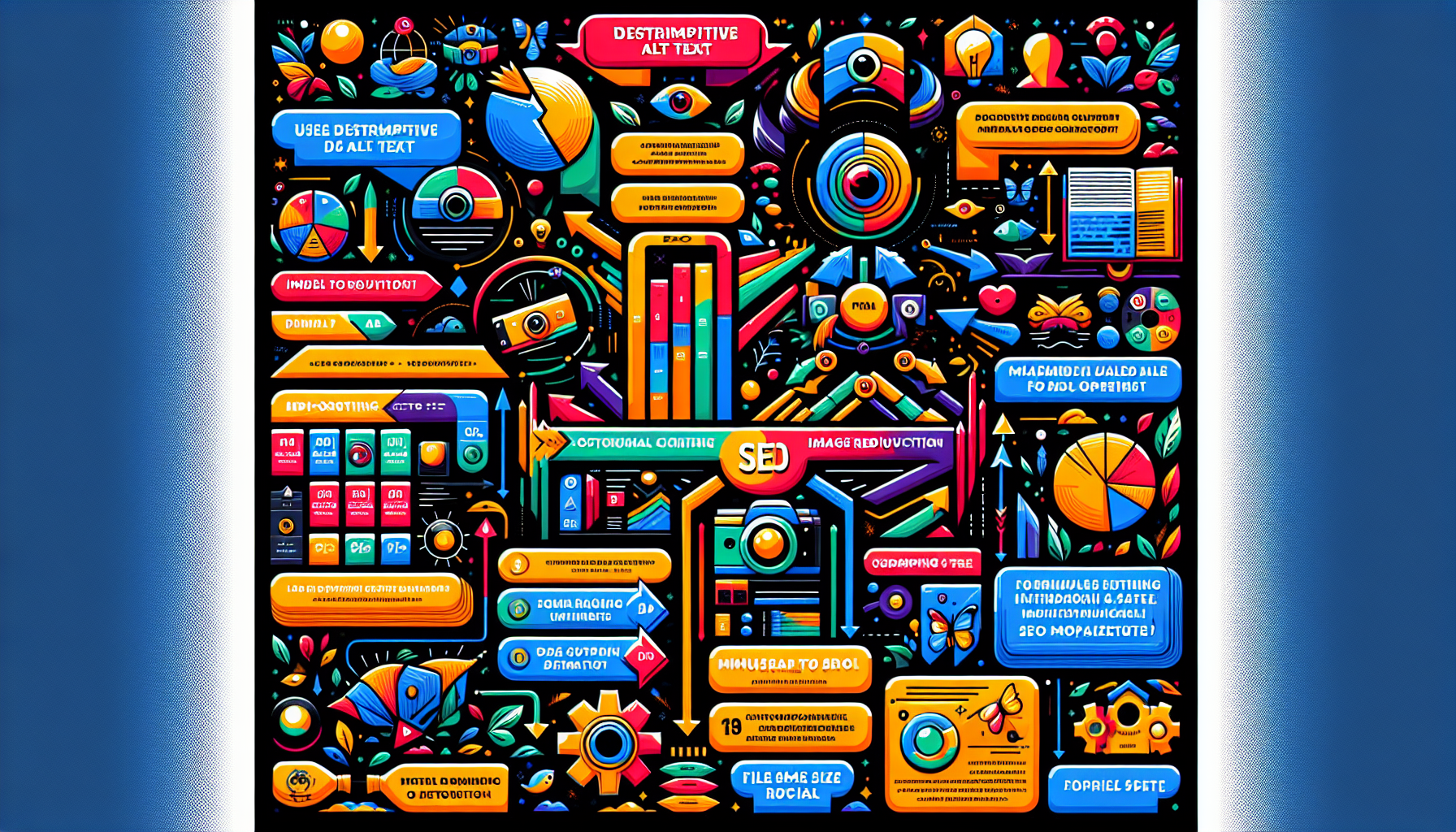What Is Onpage Optimization? Best Practices & Strategies for 2024
Learn what is onpage optimization and discover the best practices & strategies for 2024 to boost your website's search rankings.



Alex Voichenko
Content Manager

Looking to boost sales on your Shopify store?
Try our SEO tools for free and see how they can help you improve search rankings and drive more traffic to increase your sales.
Get startedOn-page optimization is the practice of tweaking elements on your web pages to improve their search engine rankings and attract more visitors. By refining content, HTML tags, and site architecture, you make your site more user-friendly and easier for search engines to index. In this context, understanding what is onpage optimization is crucial. This guide will walk you through the essential techniques and strategies for effective on-page optimization in 2024.
Key Takeaways
On-page SEO focuses on optimizing individual web pages, including elements like title tags, meta descriptions, and internal links, to improve search engine rankings and user experience.
Staying updated with SEO best practices is essential in 2024 due to evolving search engine algorithms; techniques such as schema markup and structured content can enhance visibility.
Key user experience factors such as page speed and mobile-friendliness significantly affect SEO performance; responsive web design and fast-loading sites are crucial for maintaining high rankings.
What Is Onpage Optimization? Best Practices & Strategies for 2024

On-page SEO is a method of fine-tuning the visible and underlying components of a website to enhance its ranking in search engines. The primary goal is optimizing individual web pages to rank higher in search results and attract organic traffic. On-page SEO consists of several key components, including on site seo, content elements, site architecture elements, and site seo elements. Concentrating on these components makes your website more appealing to visitors and search engines.
Effective on-page SEO involves a variety of elements that should be optimized, such as URLs, internal links, page speed, and title tags. This process enables website owners to define page topics, target audiences, and relevant keywords. The website owner determines the target audience for each page and chooses relevant keywords and phrases to focus on.
An effective on-page SEO checklist can aid in ensuring that all critical optimization elements are covered. User experience factors, such as page loading speed and bounce rate, are also vital components of successful on-page SEO. Adhering to these best practices and strategies significantly improves your website’s search engine rankings and user experience.
Introduction
Search engine algorithms are constantly evolving, making it essential to regularly update your SEO practices to maintain success in search rankings. This guide, enriched with insights from ConvertMate, a leading resource in eCommerce SEO marketing, aims to explore the factors that can make or break your SEO success.
On-page optimization involves techniques designed to boost a website’s search engine ranking and user experience. From internal links to meta descriptions, each element plays a crucial role in optimizing your web page for better visibility and engagement.
Join us as we delve into the intricacies of on-page SEO and uncover the strategies that will keep you ahead in 2024.
Understanding On-Page SEO
On-page SEO is a method of fine-tuning the visible and underlying components of a website to enhance its ranking in search engines. The purpose is to optimize individual web pages to rank higher in search results and attract organic traffic. This practice is essential for increasing visibility in search engines and ensuring your pages rank higher on Google.
Effective on-page SEO allows website owners to define page topics, target audiences, and relevant keywords. It encompasses content elements, site architecture elements, and HTML elements, all of which contribute to a well-structured site that helps search engines crawl pages effectively. The website owner determines the target audience and keyword focus for each page, ensuring that the content is relevant and appealing.
An effective on-page SEO checklist can aid in covering all critical optimization elements, ensuring no aspect is overlooked. User experience factors, such as page loading speed and bounce rate, are now vital components of successful on-page SEO factors. Understanding these elements allows you to develop a robust on-page SEO strategy that enhances performance and visibility.
Importance of On-Page SEO

In 2024, on-page SEO is more crucial than ever as it helps improve both user experience and visibility in search engines. It communicates the value of your website to Google and visitors, which is essential for ranking and attracting traffic. Approximately half of all website traffic originates from search engines, highlighting the importance of on-page SEO.
A well-optimized site can prevent it from being overshadowed by competitors in search results. On-page SEO significantly improves user experience by making websites easier to navigate and more engaging. Traditional practices, such as using specific keywords in content, still play a significant role in Google’s ranking algorithms.
Google evaluates websites based on three primary factors: on-page SEO, off-page SEO, and technical SEO. On-page SEO assists Google in recognizing and categorizing page content, making it essential for search engines to evaluate a website’s relevance to user queries on search engine results pages. The relationship between SEO and user experience is critical, as positive user interactions can lead to better search rankings.
In 2024, the optimization process has become more involved, requiring multiple steps beyond basic keyword placement.
Key Elements of On-Page SEO

Optimizing title tags, meta tags, meta descriptions, content, internal links, and URLs are key components of effective on-page SEO practices. These elements help improve search engine visibility and user experience. These elements encompass content aspects, site layout, and HTML components, all of which contribute to a well-structured site that helps search engines crawl pages effectively.
Uniqueness in content and structure significantly contributes to higher rankings beyond just keyword usage in competitive keywords.
Title Tags
Title tags are the most important factor in on-page SEO, as they give search engines an overview of the page content. They assist in improving search engine rankings by informing both users and search engines about the content of the page. To create effective title tags, ensure each page has a unique title under 60 characters, includes the target keyword, and employs descriptive language.
Using best modifiers for titles such as ‘best’, ‘guide’, ‘fast’, and ‘review’ can maintain a natural flow of keywords. Avoid over-dramatic terms in title tags that could make them appear as clickbait, such as ‘insane’ and ‘powerful’. Each page should have an original title tag to prevent duplication and improve user experience.
Placing keywords closer to the beginning of title tags increases their weight with search engines and enhances visibility. Following these guidelines helps create title tags that attract users and improve search engine rankings.
Meta Descriptions
Meta descriptions help searchers decide which result to click on. They serve as short page summaries under search results, influencing user decisions on which links to click. Having a meta description can enhance click-through rates by approximately 6% compared to pages without one. Meta descriptions can be a deciding factor between a user clicking on your page or another one.
Make sure to include both core and related keywords in the meta description. This will help enhance its relevance. For on-page SEO, the ideal length of meta descriptions is between 155 and 160 characters. It’s important to stay within this range for optimal performance. Conduct an SEO audit to find and add missing meta descriptions on pages that lack them. Meta descriptions should not reflect the content verbatim as it appears on the page.
It is not necessary to write a perfect meta description for every page; just having one is often sufficient. If a meta description doesn’t match user intent, Google may choose its own description for the SERP. Crafting effective meta descriptions improves click-through rates and enhances search engine performance.
Header Tags
Header tags, such as H1, H2, H3, etc., are HTML elements used to structure content on a web page. They enhance readability and skimmability, allowing users to quickly grasp the main ideas of the content. Using header tags helps organize content and enables search engines to identify significant sections of a page.
Best practice includes using a single H1 per page, reserved for the page title or headline. Keywords should be strategically placed in header tags, particularly in H1 and H2, to communicate the content’s purpose. Utilizing keywords within header tags can aid in clarifying the page’s purpose and improve its SEO performance.
Wrapping target keywords in header tags significantly impacts SEO results. This structured approach not only improves readability for users but also enhances your website’s visibility in search engine results.
Content Optimization Strategies
Content optimization is a critical component of on-page SEO, aligning your content with user needs and enhancing site visibility. Incorporating long-tail keywords helps enhance content relevance and attract targeted traffic. Adding author bylines to your content demonstrates experience and expertise, further boosting credibility.
Visual content enhances visual appeal, engagement, and makes content scannable, helping break up text and provide context for complex information. Optimizing images provides search engines with clues about the page content, helping it rank higher.
In 2024, the optimization process has become more involved, requiring multiple steps beyond basic keyword placement. Following best practices for content optimization can significantly improve your website’s search engine performance.
Keyword Placement
Strategic placement of target keywords is crucial as it helps attract and maintain a position on the first page of search results. Placing target keywords within the first 100 words of content is essential because Google prioritizes terms appearing early on the page. Incorporating keywords in headers and subheadings helps improve SEO relevance and aids in structuring the page.
Including keywords in the body copy is necessary for SEO as it helps improve rankings by reinforcing the content’s focus. Maintaining a balanced frequency of keywords increases Google’s confidence in defining the page’s topic, which ultimately supports better rankings. It is crucial to avoid keyword stuffing; rather, the content should flow naturally and engage the reader.
Using semantic keywords related to primary keywords enhances optimization while keeping content reader-friendly. Following these practices ensures effective keyword placement that contributes to improved search engine rankings.
Unique and Valuable Content
The first step to creating high-quality content is choosing relevant keywords. Selecting appropriate topics also plays a crucial role in this process. Creating content that is distinct from competitors significantly boosts ranking potential. Unique content means not repeating existing materials and offering fresh insights. Publishing something unique is a good starting point for creating valuable content.
For a page to remain on the first page of Google, it must satisfy user intent. If a page does not satisfy user intent, it is likely to be buried on the 3rd page. Checking for spelling and grammar is essential to ensure the quality of content. To optimize content for a Featured Snippet, include a short definition or maintain a consistent page structure for lists.
Duplicate content negatively impacts on-page SEO, so it’s important to ensure all content is original and valuable. Focusing on unique and valuable content enhances your website’s visibility and user engagement.
URL Structure and Optimization
Clear and descriptive URLs are essential for improving search engine rankings and aiding content relevance identification. An SEO-friendly URL should incorporate relevant keywords while remaining straightforward for users and search engines. Best practices for URL structure include keeping URLs concise, using lowercase letters, and separating words with hyphens.
Following these guidelines creates URLs that are easy to understand and navigate, improving user experience and search engine performance. This structured approach to URL optimization can significantly contribute to your overall SEO strategy.
Internal and External Linking
Internal linking involves hyperlinking to other helpful pages on your website, and it is crucial for effective site navigation. Creating a cohesive network of related content through strategic internal linking enhances user navigation and retention, significantly improving SEO by directing link equity between pages. Strategically placed internal links can guide users toward conversions and improve key user metrics such as bounce rate and time spent on site.
Internal links also aid search engine crawlers in discovering and indexing new content, helping to establish relationships between pages. To optimize internal links, use keyword-rich anchor text and aim for at least two to three internal links for new pages.
Regularly review and maintain internal links to ensure they remain valid and direct to intended destinations. High-quality external links to relevant, authoritative sites enhance the credibility of a webpage, signaling trustworthiness to both users and search engines.
Image and Multimedia Optimization

Images account for almost 19% of Google’s search results, making their optimization essential for capturing organic traffic. Effective alt text can increase image traffic, leading to more organic visitors to a website. Using descriptive filenames in addition to alt text helps Google and visually impaired users understand images. Including your keyword in the image filename and alt tags is an effective technique for image optimization.
Following W3C guidelines by providing equivalent alternatives to auditory and visual content enhances accessibility. Effective alt text can significantly enhance user experience by providing context when images fail to load.
Alt text makes content accessible to everyone browsing the site, particularly for those with visual impairments. By writing descriptive alt text and using descriptive file names, you can optimize your images for better search engine performance and user experience.
Page Speed and Mobile-Friendliness

Page speed is a significant ranking factor for search engines, influencing how websites perform in search results. Loading time is critical; most users will leave a site that takes longer than three seconds to load.
Mobile friendliness is crucial for SEO as it serves as a ranking signal for search engines when users search on mobile devices. Websites that are optimized for mobile typically rank higher in search results on mobile devices. Google’s mobile-first indexing means that mobile versions of websites are prioritized in search rankings.
Implementing responsive web design is recommended by Google as the best way to achieve mobile friendliness. Using Google’s Accelerated Mobile Pages (AMP) can significantly improve loading speeds and enhance the mobile user experience.
To improve site speed, consider compressing images and eliminating unnecessary website code. By focusing on these aspects, you can ensure your website loads quickly and provides a seamless experience for mobile users, ultimately enhancing your search engine rankings.
Advanced On-Page SEO Techniques
Utilizing advanced techniques can signal to search engines and other search engines the quality and context of website content, enhancing visibility.
Schema Markup
Schema markup is a type of code. It assists search engines in understanding and categorizing web pages. It allows search engines to better understand the information on a website, improving visibility and user experience. Using schema markup helps optimize for Google’s Search Generative Experience (SGE), enhancing content visibility. Structured data contributes to a better on-page experience for visitors, which can improve search performance.
Product markup is a common type of schema. It provides details about pricing and review ratings. The Structured Data Testing Tool can be used to check if your schema markup is set up correctly. Implementing schema markup enhances your website’s visibility and overall user experience.
Featured Snippets
Creating content that provides clear, concise answers increases the chances of appearing in featured snippets. Featured snippets are selected search results that appear at the top of Google’s organic results, providing a quick answer to user queries. To optimize for featured snippets, structure content with bullet points, numbered lists, and concise paragraphs.
Effectively structuring your content increases the likelihood of your page being featured in prominent positions, driving more traffic and improving search engine rankings.
Monitoring and Updating On-Page SEO
Tracking existing content is essential for maintaining high search rankings and ensuring relevance. Regular monitoring of on-page SEO metrics helps to identify potential issues and opportunities. Regular updates of high-ranking articles can significantly enhance their performance and search visibility. Changes in search engine algorithms or user intent can affect content relevance, requiring updates to maintain rankings.
Continuously working on your on-page SEO aims for maintaining an effective digital presence. Automating content performance tracking can save time and improve the efficiency of SEO audits. Tools like Clearscope can assist in monitoring content performance and suggest updates based on current trends. ConvertMate tracks over 20 data points to monitor performance, integrating with platforms like Google Search Console for ongoing optimization.
An effective on-page SEO checklist can aid in ensuring that all critical optimization elements are covered. Regularly monitoring and updating your on-page SEO maintains a strong online presence and improves search engine rankings.
ConvertMate: The Ultimate Tool for On-Page SEO
ConvertMate is designed to automate SEO work for Shopify stores. It is particularly suited for Shopify Plus, Advanced, agencies, and growing brands that are serious about growth. ConvertMate conducts research and audits to identify ways to enhance a store’s visibility and performance online.
ConvertMate provides tailored suggestions for each page of the store based on keyword strength and overall website health. It tracks over 20 different data points and integrates with tools like Google Search Console to refine content continually. Users of ConvertMate have reported an average organic traffic increase of +84%, and an average increase in conversion rates of +29%.
Clients praised ConvertMate for its wonderful customer service and effective communication. With an additional $23 million in sales generated across all merchants, ConvertMate has proven to be an invaluable tool for eCommerce brands looking to improve their on-page SEO and overall digital presence.
Summary
In summary, on-page SEO remains a vital component of digital marketing in 2024. By focusing on key elements such as title tags, meta descriptions, header tags, and content optimization, you can significantly improve your website’s search engine rankings and user experience. Advanced techniques like schema markup and optimizing for featured snippets further enhance your visibility and engagement.
ConvertMate stands out as the ultimate tool for on-page SEO, providing tailored suggestions and tracking multiple data points to ensure ongoing optimization. By leveraging these strategies and tools, you can stay ahead in the competitive digital landscape and achieve sustained growth.
Frequently Asked Questions
What is the primary function of ConvertMate?
ConvertMate primarily functions to automate SEO tasks specifically for Shopify stores, enhancing their online visibility and performance.
How does ConvertMate handle large catalogs?
ConvertMate efficiently manages large catalogs, ensuring smooth operation and organization. This capability allows businesses to handle extensive inventories without compromising performance.
How does ConvertMate improve a Shopify store's visibility?
ConvertMate enhances a Shopify store's visibility by conducting research and audits to identify effective strategies for improving online performance. This targeted approach ensures that your store attracts more potential customers.
What kind of suggestions does ConvertMate provide?
ConvertMate offers personalized recommendations for each store page, focusing on keyword effectiveness and overall website performance.
What feedback did clients provide about ConvertMate's customer service?
Clients have consistently praised ConvertMate for its outstanding customer service and effective communication. This positive feedback highlights their commitment to client satisfaction.



Simplified SEO for Shopify brands
& agencies
Grow organic traffic. Enhance visibility. Convert clicks to orders—no fluff.





